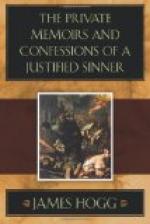|
This section contains 7,837 words (approx. 27 pages at 300 words per page) |

|
SOURCE: Jones, Douglas. “Double Jeopardy and the Chameleon Art in James Hogg's Justified Sinner.” Studies in Scottish Literature 23 (1988): 164-85.
In the following essay, Jones argues against psychoanalytic interpretations of The Private Memoirs and Confessions of a Justified Sinner, concentrating instead on the narrative's concern with subjectivity, ambiguity, circularity, and disguise.
Critics of James Hogg's Private Memoirs and Confessions of a Justified Sinner have often cited Coleman Parson's observation that, for Hogg, the supernatural is “a corridor leading to the ultimate strangeness, that the individual is both tempter and tempted.”1 The (critical) temptation which follows is that of treating Gil-Martin as Robert Wringhim's psychological double, and the text as a tension between supernatural and psychological explanations for the action. Such a reading is not implausible. But locating Justified Sinner within a Romantic/psychological doppelganger tradition is finally too easy—and to say that the story teeters on the edge...
|
This section contains 7,837 words (approx. 27 pages at 300 words per page) |

|


